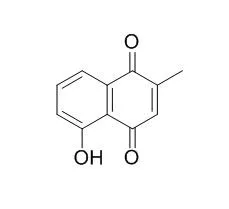| Kinase Assay: |
| Cell Stress Chaperones. 2015 Jul;20(4):621-9. | | Plumbagin protects against glucocorticoid-induced osteoporosis through Nrf-2 pathway.[Pubmed: 25939783] | Long-term and high-dose glucocorticoids (GCs) supplementation has been linked to osteoporosis.
METHODS AND RESULTS:
In this study, we studied the protective role of Plumbagin against GC-induced cell damage in MC3T3-E1 cells. The effect of dexamethasone (DEX) and Plumbagin on cell viability was determined. DEX showed as IC-50 value of 95 μM. Further, 10 μM Plumbagin treatment effectively ameliorated DEX-induced cell death by increasing the cell viability to 92 %. A further effect of Plumbagin on DEX-induced oxidative stress was determined through reactive oxygen species (ROS) level, lipid peroxide content, and antioxidant status. Nrf-2 nuclear localization was analyzed through immunofluorescence. Protein expression of redox regulator Nrf-2 and their target genes HO-1 and NQO1 and osteogenic markers (OCN, OPN Runx-2) were determined by Western blot. Apoptotic effect was analyzed by mitochondrial membrane potential and caspase activities (3, 8, and 9). The results showed that DEX treatment showed a significant increase in oxidative stress through increased ROS levels and downregulation of cytoprotective antioxidant proteins and antioxidant enzyme activities. Further DEX treatment downregulated the osteogenic markers and upregulated apoptosis through decreased mitochondrial membrane potential and upregulation of caspase activities. Plumbagin treatment significantly reversed the levels of oxidative stress and apoptotic markers and protected against DEX-induced cell damage. Further, Plumbagin treatment significantly improved the expression of osteogenic markers compared to DEX treatment.
CONCLUSIONS:
In conclusion, the present study shows that Plumbagin offers significant protective role against DEX-induced cellular damage via regulating oxidative stress, apoptosis, and osteogenic markers. | | J Neurooncol. 2015 Feb;121(3):469-77. | | Plumbagin induces growth inhibition of human glioma cells by downregulating the expression and activity of FOXM1.[Pubmed: 25528634] | Plumbagin, a natural quinonoid constituent isolated from the root of medicinal plant Plumbago zeylanica L, has exhibited anti-tumor and anti-proliferative activities in various tumor cell lines as well as in animal tumor models.
METHODS AND RESULTS:
We reported that Plumbagin could effectively inhibit cell proliferation, migration and invasion and induce apoptosis of glioma cells.
Cell cycle assay showed that Plumbagin induced G2/M arrest. Interestingly, we found that Plumbagin decreased the expression of FOXM1 both at mRNA level and protein level. Plumbagin also inhibited the transactivation ability of FOXM1, resulting in down-regulating the expression of FOXM1 downstream target genes, such as cyclin D1, Cdc25B, survivin, and increasing the expression of p21(CIP1) and p27(KIP1). Most importantly, down-regulation of FOXM1 by siFOXM1 transfection enhanced Plumbagin-induced change in viability. On the contrary, over-expression of FOXM1 by cDNA transfection reduced Plumbagin-induced glioma cell growth inhibition. These results suggest that Plumbagin exhibits its anticancer activity partially by inactivation of FOXM1 signaling pathway in glioma cells.
CONCLUSIONS:
Our findings indicate that Plumbagin may be considered as a potential natural FOXM1 inhibitor, which could contribute to the development of new anticancer agent for therapy of gliomas. |
|






 Cell. 2018 Jan 11;172(1-2):249-261.e12. doi: 10.1016/j.cell.2017.12.019.IF=36.216(2019)
Cell. 2018 Jan 11;172(1-2):249-261.e12. doi: 10.1016/j.cell.2017.12.019.IF=36.216(2019) Cell Metab. 2020 Mar 3;31(3):534-548.e5. doi: 10.1016/j.cmet.2020.01.002.IF=22.415(2019)
Cell Metab. 2020 Mar 3;31(3):534-548.e5. doi: 10.1016/j.cmet.2020.01.002.IF=22.415(2019) Mol Cell. 2017 Nov 16;68(4):673-685.e6. doi: 10.1016/j.molcel.2017.10.022.IF=14.548(2019)
Mol Cell. 2017 Nov 16;68(4):673-685.e6. doi: 10.1016/j.molcel.2017.10.022.IF=14.548(2019)